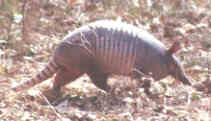
Armadillo is Spanish for 'man-in-armour'. Although the Armadillo looks like a turtle, its closest relative is the anteater. The armadillo is an amazing digger. It uses strong front claws to loosen the earth, which it then scoops away with its hind legs.
An armadillo can hold its breath for several minutes at a time. This helps to stop it choking on soil and dust that flies up as it digs and it’s also a useful skill when it goes for a dip. In spite of all that heavy body armour, armadillos are great swimmers. All that activity means they need plenty of energy and one armadillo can eat up to 100kg of insects, grubs and worms a year.
There are six species of armadillo and they’re found from Argentina through Central America to Florida. Over the last 150 years, the nine-banded armadillo has spread throughout south east United States at a very fast rate. They were first observed in the USA in 1849 and as the towns grew, the armadillos moved in. Although humans have provided good digging territory, armadillos are often hit by cars when they stray into residential areas.
You can tell one armadillo from another by its bands. The three-banded armadillo has an extra skill – it can roll up into a ball to protect itself from predators. The nine-banded armadillo has to rely on the safety of its burrow. It wedges itself inside with its strong claws and is almost impossible to shift! When startled this peculiar creature can leap up to a metre in to the air. Female armadillos have four identical babies that are born with their armour on! The plates are soft and leathery to start with and gradually harden as the armadillo gets older.
In Texas, the armadillo has a bit of a cult following. People hold dillo races, form fan clubs and keep them as pets and since 1995 they’ve been the official state animal.







No comments:
Post a Comment